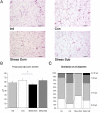Metabolic consequences and vulnerability to diet-induced obesity in male mice under chronic social stress
- PMID: 19180229
- PMCID: PMC2628728
- DOI: 10.1371/journal.pone.0004331
Metabolic consequences and vulnerability to diet-induced obesity in male mice under chronic social stress
Abstract
Social and psychological factors interact with genetic predisposition and dietary habit in determining obesity. However, relatively few pre-clinical studies address the role of psychosocial factors in metabolic disorders. Previous studies from our laboratory demonstrated in male mice: 1) opposite status-dependent effect on body weight gain under chronic psychosocial stress; 2) a reduction in body weight in individually housed (Ind) male mice. In the present study these observations were extended to provide a comprehensive characterization of the metabolic consequences of chronic psychosocial stress and individual housing in adult CD-1 male mice. Results confirmed that in mice fed standard diet, dominant (Dom) and Ind had a negative energy balance while subordinate (Sub) had a positive energy balance. Locomotor activity was depressed in Sub and enhanced in Dom. Hyperphagia emerged for Dom and Sub and hypophagia for Ind. Dom also showed a consistent decrease of visceral fat pads weight as well as increased norepinephrine concentration and smaller adipocytes diameter in the perigonadal fat pad. On the contrary, under high fat diet Sub and, surprisingly, Ind showed higher while Dom showed lower vulnerability to obesity associated with hyperphagia. In conclusion, we demonstrated that social status under chronic stress and individual housing deeply affect mice metabolic functions in different, sometime opposite, directions. Food intake, the hedonic response to palatable food as well as the locomotor activity and the sympathetic activation within the adipose fat pads all represent causal factors explaining the different metabolic alterations observed. Overall this study demonstrates that pre-clinical animal models offer a suitable tool for the investigation of the metabolic consequences of chronic stress exposure and associated psychopathologies.
Conflict of interest statement
Figures







References
-
- Bjorntorp P. Do stress reactions cause abdominal obesity and comorbidities? Obes Rev. 2001;2:73–86. - PubMed
-
- McEwen BS. Protective and damaging effects of stress mediators. N Engl J Med. 1998;338:171–9. - PubMed
-
- Sapolsky RM, Romero LM, Munck AU. How do glucocorticoids influence stress responses? Integrating permissive, suppressive, stimulatory, and preparative actions. Endocr Rev. 2000;21:55–89. - PubMed
-
- Dallman MF, la Fleur SE, Pecoraro NC, Gomez F, Houshyar H, et al. Glucocorticoids-food intake, abdominal obesity, and wealthy nations in 2004. Endocrinology. 2004;145:2633–8. - PubMed
Publication types
MeSH terms
Substances
LinkOut - more resources
Full Text Sources
Medical

